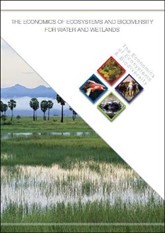 |
|
TEEB For Water and Wetlands
The “nexus” between water, food and energy has been recognised as one of the most fundamental relationships and challenges for society. Wetlands are a fundamental part of local and global water cycles and are at the heart of this nexus, providing numerous ecosystem services to humankind. Nonetheless, wetlands continue to be degraded or lost and, in many cases, policies and decisions do not sufficiently take into account these interconnections and interdependencies. However, the full value of water and wetlands needs to be recognized and integrated into decision-making in order to meet our future social, economic and environmental needs. Using the maintenance and enhancement of the benefits of water and wetlands is, therefore, a key element in a transition to a sustainable economy.
Read more / download |